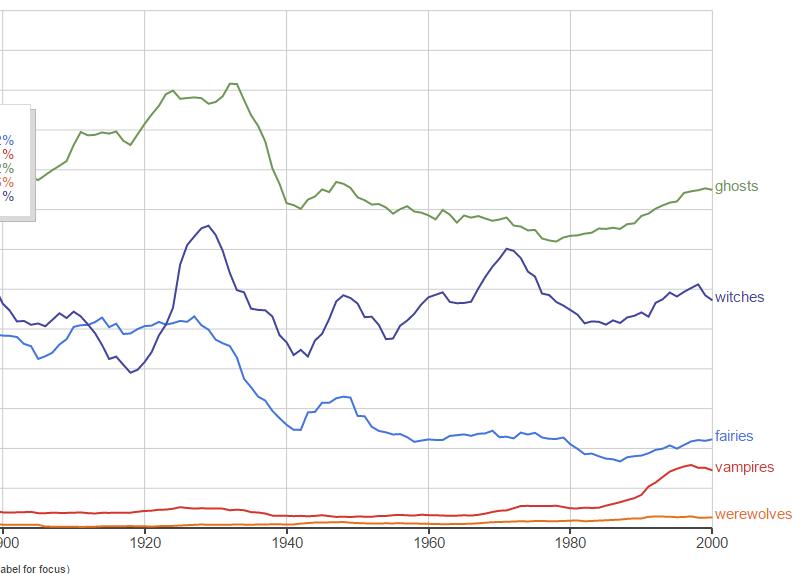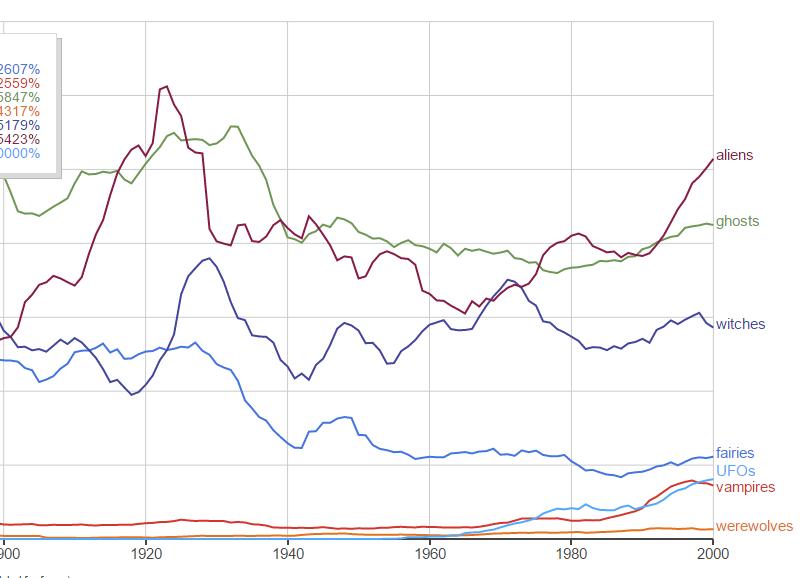The Supernatural on Ngram April 19, 2017
Author: Beach Combing | in : Actualite, Contemporary , trackbackBeach has recently been messing about with Ngram, as his leisurely ancestors used to mess around on southern English rivers. Ngram for the uninitiated is a Google tool that allows the user to measure the frequency of certain words in Google Books. It is not as sophisticated as Google Analytics, which measures search terms. But it goes give a crude sense of what words are or are not used and when over a much longer period. As his main area of interest is the supernatural Beach tried to measure the way that five words are used in English: fairies, ghosts, vampires, werewolves and witches. He was actually interested in the first two but the second three were put in as controls.
Admittedly this is all very approximate but Beach is struck by the striking fall in uses of ‘fairy’ and ‘ghost’ in the early mid twentieth century. Fairy starts to be used less from 1926 and ghost from 1933; the fall continues for fairies until 1942 and for ghosts until 1941. Both grow modestly for a decade or so and then flatline through to the 1980s. There may be a problem inherent in Ngram here. Perhaps there is something in the number of scanned Google Books that creates these patterns? Perhaps. But here the trajectory of vampires, werewolves suggests not; though witches are broadly speaking trending in the same way. Accepting, for a moment, that this data is telling us something about belief rather than about the cogwheels at the centre of Ngram, what does this mean? Why a fall off in interest in fairies/ghosts in the late twenties early thirties, a brief revival in the 1940s, and then the flatlining till the 1980s.
Beach can only speak in generalities here but the first part of the graph is approximately what he would expect. After the First World War there was an unusual interest in the spirit world, not least in the shadow of that dreadful soul-destroying conflict over the bogs of Flanders. There is, then, a hardening in western culture as the depression and the unpleasant political climate of the 1930s kicks in. If he hadn’t seen this graph he would have guessed that from the 1930s to the 1990s interest in fairies and witches was less save for a brief peak in the 1960s when flower power, LSD and Woodstock would have given a spike. (If anything this seems to be true for witches!) He would not have guessed the jump in the 1940s. He would have assumed that the 1979s would have been the worst period for fairies and ghosts: the hangover from the Age of Aquarius. He would have expected, too, the 1990s to be the point of take off,* not the 1980s.
Is there any other data that can be brought to this chart. Something that would be useful would be a measurement of interest in alien visitors to the planet earth. But here we run into language problems. UFOs seems only to have properly entered English in the late 1960s; while ‘alien’ has just too many other meanings. However, here is the chart for what it is worth. The one strong impression is that interest in these two words really takes off in the early 1990s. It would be difficult, on the basis of this evidence, to argue that UFOs somehow took over from fairies and ghosts from the 1960s, as is sometimes done.
Any other thoughts or pointers to flaws in ngram: drbeachcombing At yahoo DOT com
*When to use a phrase from Portlandia ‘you know people were getting piercings and tribal tattoos and talking about saving the planet and forming bands… remember when people were content to be unambitious and to sleep into till 11, maybe working a couple of hours a week at a coffee shop… you could grow up to want to be a clown’.
30 Apr 2017: Bruce T writes, ‘Drop “UFO” to see what happens between 1945-1970. “UFO” began to supplant “Flying Saucer” in the late 60’s here. Interesting that Werewolf upticks in the early 80’s at the time the superbly crafted “An American Werewolf In London” hit the big screens and the equally bad “Teen Wolf” series with Michael J. Fox does the same. I agree “alien” is much too broad. It starts to peak during the mass immigration from S. and E. Europe to the US in the early 20th cen., climbs through the roof with the idea of enemy aliens during WWI and skyrockets just after the Russian Revolution and the massive Red Scares throughout the West., all within 15-20 year period. As our UFO pilots seem to change from era to era and sighting to sighting, I don’t have the slightest idea of a good way define them under a working term? I like “Moon Men” but I only use it to tick the believers off. Ghost’s and witches have been with us since time immemorial. Perhaps the uptick in witches comes from the shock of two major world wars and the development of weapons that could wipe out civilization as we know it? People casting about for belief system anathema to the age of science and reason that just brought about 30 years of pure Hell, an economic collapse in between, and two blocs with the new wonder weapons at loggerheads seemingly ready to use them at the drop of a hat. What’s more anti-reason and anti-logical than casting spells to control the world around you? The uptick in witchcraft in the 40’s may be an “up yours” to the world of science and reason. An aside a Crowleyite sect became established on the campus of CalTech for a brief time in the post WWII era. This was where many of the men who had worked on the atomic bomb had gone to teach post war. I’d expect Crowleyites at other elite Universities, but at arguably the top science institute in the world at that time? It gives an insight into how deep the revulsion to the entire previous era was. Ghosts are simply a device to deal with the greatest unknown of all, death. There is always going to be a spike in interest in them after a mass slaughter either via war or disease. My guess is you could lump “witches and mediums” in there, too, as they provide a supposed means for contact with the dead.




